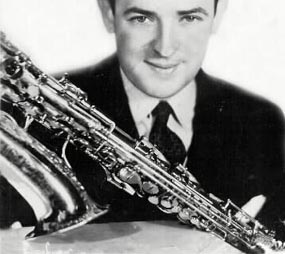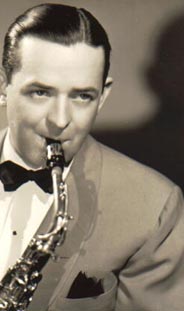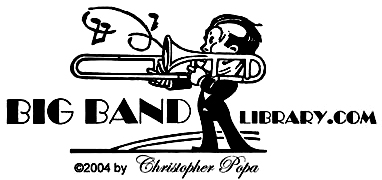
JIMMY DORSEY
"So Rare"
by Christopher Popa December 2004
He may have been older, shorter, and seemingly not quite as driven as Tommy. But alto saxophonist - clarinetist Jimmy Dorsey had something which his brother didn't.
"I think it would be his tolerance and understanding of his musicians," Roc Hillman, who played guitar in Jimmy's band for five years, told me in 2004, the 100th anniversary of Dorsey's birth. "I can't remember one instance where he came up short in tolerance."
Jimmy always was considered an easy-going, gentle soul.
"I would say so," Hillman agreed, "compared with other leaders I worked with. And compared with his brother."
That doesn't necessarily mean that Jimmy would have been content to sit in the sax section of the Dorsey Brothers band, which they organized together in 1934, and let Tommy call the shots indefinitely.
"No. He tolerated Tommy more than he should have," according to Hillman. "Tommy could blow off very easily. He never tried to correct that much. Tommy had his good side, but he had his other,
short-tempered side."
So Tommy wouldn't just fight with his brother, he could fight with anybody.
"Yes, that's right," he said. "I remember, his blowing off was [with] quite a few people."
Did Jimmy consider himself more one of the guys, as opposed to the boss?
"No, not exactly one of the guys," he answered.
Still, when Jimmy later led his own band, it was always well-rehearsed, but not uptight.
"Even when somebody goofed, he sort of understood and didn't hold it against him, as I remember," he explained.
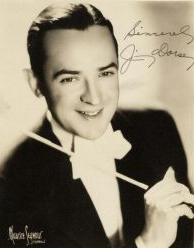
vital stats:
given name James Francis Dorsey
birth Feb. 29, 1904, Shenandoah, PA
death June 12, 1957, New York City,
cancer
heritage Irish
father Thomas Francis Dorsey, Sr.,
b.1872, d.1942
occupation music teacher, Lansford
High School, Lansford, PA
mother Theresa "Tess" Langton,
b.1874, d.1968
brother Thomas "Tommy" F., Jr.,
b.1905, d.1956
brother Edward L., b.1911, d.1914
sister Mary (Mrs. Anthony Lisella)
education public schools in
Shenandoah and Lansford, PA
instruments slide cornet (age 6), valve
cornet and trumpet (age 8), alto sax
and clarinet (age 13)
first band "Dorsey's Novelty Six-The
Jazz Band of 'em All," 1920
wife Jane Porter, m. Nov. 5, 1927, div.
1949
daughter Julie Lou (Mrs. Robert C.
Hilton)
physical description brown eyes, black
hair, 153 lbs., 5'8"
hobbies golf
memberships AFM locals 802 and 47;
ASCAP
residence 18 Toluca Estates Dr.,
Hollywood, CA
But on Decoration Day (May 30th), 1935, the tune I'll Never Say "Never Again" Again -- which featured Hillman, Herfurt, and Matteson in a vocal trio -- proved to be the breaking point.
"Well, it wasn't a night, it was an afternoon job," Hillman corrected me. "It was a holiday, and we were doing our regular routine. But I do recall that Jimmy was a little hung over from the night before. He was celebrating, the night before. Tommy stood in front of the band, of course, and when he called out . . . the song and kicked it off, Jimmy looked at him and said, 'Mac...' He called Tommy "Mac," Jimmy did. He said, 'Mac, it's too fast.' Then Tommy says, 'Oh yeah?' And this is while we were singing the trio on the song. As I say, Jimmy was slightly hung over at the time, just slightly hungover. And Tommy didn't take it at all well, and right there he says, 'Well, you do it!' He grabbed his trombone and walked off the stand, which was very unheard of."
By that date, Hillman had switched to playing guitar in the band.
"They liked our trio, which was already organized and dropping out the bass when the trio sang wasn't favorable with them and so they knew that I had played guitar . . . I guess they had room enough for a guitar at that time, and I did play good guitar. But the trio was the main factor in the band then."
In an ensemble such as the Dorsey Brothers Orchestra, the guitar was less important than the bass.
"A bass fiddle was one of the absolute necessities of a good jazz band," he stated. "But they liked the idea that I played guitar. I didn't hear any dissention on it, and Jimmy agreed even when Tommy left that they liked the trio . . . We were quite versatile. We had that build-up in Denver and we had plenty of experience."
There was no opportunity for guitar solos with Jimmy's band.
"Hardly at all, just maybe introductions," he admitted. "I didn't play solos at all, I was just a rhythm man."
How did Jimmy alter the sound of the band after Tommy left?
"I believe you could say not at all," Hillman told me, "because he kept the whole library. And when Tommy walked off, Jimmy had trombonists from the popular bands around New York to sit in, and didn't hire any of 'em. But both Tommy and Jimmy remembered Bobby Byrne whom we had met up in Detroit, and he was 17 or 18 and they were very impressed. So Jimmy gave Bobby Byrne a call, and Bobby talked with his dad, and they hired Bobby."
Tommy, meanwhile, had taken over what had been Joe Haymes' band and made it into his own.
"Tommy worked his popularity up quite well at that time," he stated. "He was a worker on this position and it was his life, really. Tommy . . . within the first year... he was a popular band."
Now the leader of what used to be the Dorsey Brothers band, Jimmy remained laid-back.
"Yes, he was," he reported. "Jimmy was quite cordial, compared to Tommy. I never heard Jimmy blow off at all."
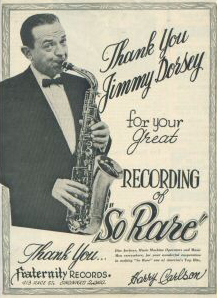
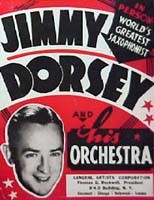
recommended listening - select list:
Parade of the Milk Bottle Caps Pat McCarthy, arranger / Decca, 1936
In a Sentimental Mood Decca, 1936
John Silver Ray Krise, arranger / Decca, 1938
Dusk in Upper Sandusky Larry Clinton, arranger / Decca, 1938
All of Me Helen O'Connell, vocal / Decca, 1939
The Breeze and I Bob Eberly, vocal / Decca, 1940
Contrasts Decca, 1940
I Understand Bob Eberly, vocal / Decca, 1940
Amapola (Pretty Little Poppy) Bob Eberly and Helen O'Connel, vocal /
Toots Camarata, arranger / Decca, 1941
Maria Elena Bob Eberly, vocal / Toots Camarata / Decca, 1941
Green Eyes (Aquellos Ojos Verdes) Bob Eberly and Helen
O'Connell, vocal / Toots Camarata, arranger / Decca, 1941
Tangerine Bob Eberly and Helen O'Connell, vocal / Toots Camarata,
arranger / Decca, 1941
In a Little Spanish Town Howard Gibeling, arranger / Standard, 1949
So Rare The Arthur Malvin Singers, vocal / Fraternity, 1956
Jimmy's band was hired to back singer Bing Crosby on the "Kraft Music Hall with Bing Crosby," an NBC radio program, an association which lasted from January 2, 1936 through July 1, 1937. (The Dorsey Brothers had worked and recorded with Bing a few years before.)
"Well, yeah, it was definitely a feature for Bing Crosby," Hillman admitted. "We were so lucky... the booking office in New York talked Crosby into having us."
Though Crosby was featured on the radio show, leaving vocalist Bob Eberly on the sidelines, Eberly became a star with Jimmy's band in personal appearances and on Decca Records.
"It didn't cut him out. We played other jobs," he explained. "In fact, we played a big ballroom session for several weeks here in Los Angeles [the Palomar, 1/8-4/13/36] while we were on the [Kraft] show."
Hillman briefly addressed several of Jimmy's sidemen, including
saxophonist Herfurt, who switched to Tommy's band in July 1937.
"That surprised me," he said.
Ray McKinley remained on drums for two years beyond that.
"Well, I figured he was one of the very best," he commented.
It was arranger Toots Camarata who wrote the charts that changed
tempo from Eberly's ballad voice, to a solo by Jimmy, then to a fast
chorus by Helen O'Connell, who had joined the band in December 1938.
"He did it, and it came off real good," he observed. "After the war [World War II], he went over to Europe and made himself quite a name."
So Camarata deserves a lot of credit.
"Quite a bit," Hillman agreed. "He's very talented."
In ever-increasing numbers, crowds showed up to see Jimmy's band in-person, including at the Ritz Ballroom in Bridgeport, CT; the Meadowbrook in Cedar Grove, NJ; the Hershey Park Ballroom in Hershey Park, PA; and the Hotel Pennsylvania in New York City.
"It was amazing to us the popularity we had," he recalled.
Hillman first met Jimmy around 1934.
"Yes," he reminisced. "I went with two other musicians from Colorado University with Glenn Miller, when he came through Denver."
Miller was musical director of a band backing Smith Ballew, a vocalist from Texas. The group was traveling, and happened to be changing personnel at the time.
"The fact that Glenn Miller went to Colorado University also had something to do with it," he observed. "But I was playing bass and I took Benny Goodman's brother's place, because he was going back to join Benny. Boy, that was really a break for me! And the two others from Colorado University [were] Skeets Herfurt and Don Matteson. The three of us had a vocal trio that worked within a band. Anyway, Glenn hired the three of us and Kay Weber, the girl vocalist in the band that we were with. I remember very well, I drove back from Denver to New York - the other fellows were in my car, I was the driver. And it was a stormy... one of the worst rainstorms in so many years... and we were very lucky to get to New York on time. But when we got to New York City, the club that we were supposed to open, with Glenn Miller, had folded just before we got there. The beauty of it was that Glenn got together with Tommy and Jimmy immediately, and on the second night -- you'll forgive me for going through this, I'm testing my memory -- the second night, I believe it was, that we were in New York City, Glenn had Tommy Dorsey come up to our hotel room and meet the three of us . . . he heard us play a little bit . . . Tommy and Jimmy had done quite a few jobs together around New York City with other big bands, but they didn't have a steady band, so Glenn talked Tommy and Jimmy into creating a steady band."
That was an important moment in popular music.
"It was definitely making history," Hillman laughed. "It was like a fairy tale. The three of us, college boys... and we used to sit in Skeets Herfurt's basement and play records of the Dorseys ... and here we are, less than a month later, with... well, the two top musicians in the country."
The Dorsey Brothers band landed its first important engagement at the Sands Point Casino on Long Island, then opened at Glen Island Casino on May 15, 1935. They also had a recording contract with Decca, and among their best sides were St. Louis Blues, Milenberg Joys, Dinah, Honeysuckle Rose, Basin Street Blues, and Stop, Look and Listen.
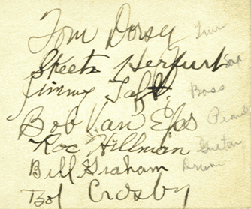
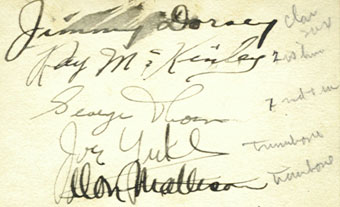
Presently age 94, Hillman includes a dose of good music (along with exercise and a healthy diet) as part of each day.
"Well, I had record players for years, but recently, my 78 player went out, and the fellow that took it over and was going to look into it, passed away just within the last few months. . . . But I have a tape player, and I still play Jimmy's recordings . . . everyday."
And he continues to feel that J.D. was a nice guy who -- contrary to the old adage -- didn't finish last.
"Jimmy was a good friend of mine, and a wonderful musician," Hillman concluded. "I would think that he was proud of the status that he had with the big band. He got up in the top, as you know - in the top five or three or so. And I can't say that I remember Jimmy resenting anything about it. He was happy."
Hillman left Jimmy in April 1940, the same month that the band recorded his novelty song I Bought a Wooden Whistle, sung by O'Connell.
"I still have a tape of that, which I play now and then," he laughed.
He moved over to Kay Kyser's band and wrote more pop tunes along the way, such as the hit ballad My Devotion, in 1942.
"I took My Devotion around to 8 or 9 publishers before one of them took it," he revealed. "I never imagined that it would come up to #1, but I had great hopes and that's why I stayed on it."
Then came Pushin' Sand, arguably the most swinging thing Kyser ever did.
"It was some sort of a dance in the Black community," he explained, "and the fellow I wrote it with liked the title, and so I went ahead with the title. And most people don't know what it means . . . I'm surprised that I still get performances on it, and especially in Europe."
A third success for Hillman was the instrumental Cumana, which became a feature for pianist Barclay Allen with Freddy Martin's band.
With all that success of which he was a part, what memories of being with the Dorsey band does Hillman now hold most dearly?
"I believe I'd have to think that over a bit," he said. "I have quite a big scrapbook, and I refer to that for events and people. I'd have to look in my scrapbook. But, all in all, I got along with Jimmy quite well."
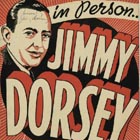
sources:
Campomizzi, Kathryn. "Dorsey Brothers still fabulous:
Big-band legends' legacy lives on across anthracite region,"
Pottsville Republican & Evening Herald, pottsville.com
"Dorsey, Jimmy" in Who Is Who in Music (Chicago: Who Is Who
in Music, Ltd., 1951), pp.150-151.
"Find a Grave," findagrave.com
"Jimmy Dorsey," in Metronome, Jul. 25, 1957, p.21.
"Jimmy Dorsey, 53, Dead of Cancer: Band Leader, Called King of
Juke Boxes, Succumbs 7 Months After Brother," New York
Times, Jun. 13, 1957, p.31, col.1.
Popa, Christopher. Telephone interviews with Roc Hillman,
Nov. 5-6, 2004.
Stockdale, Robert. Jimmy Dorsey: A Study in Contrasts
(Lanham, MD: The Scarecrow Press, Inc., 1999).
send feedback about Jimmy Dorsey: "So Rare" via e-mail
return to Biographical Sketches index
go to Big Band Library homepage
